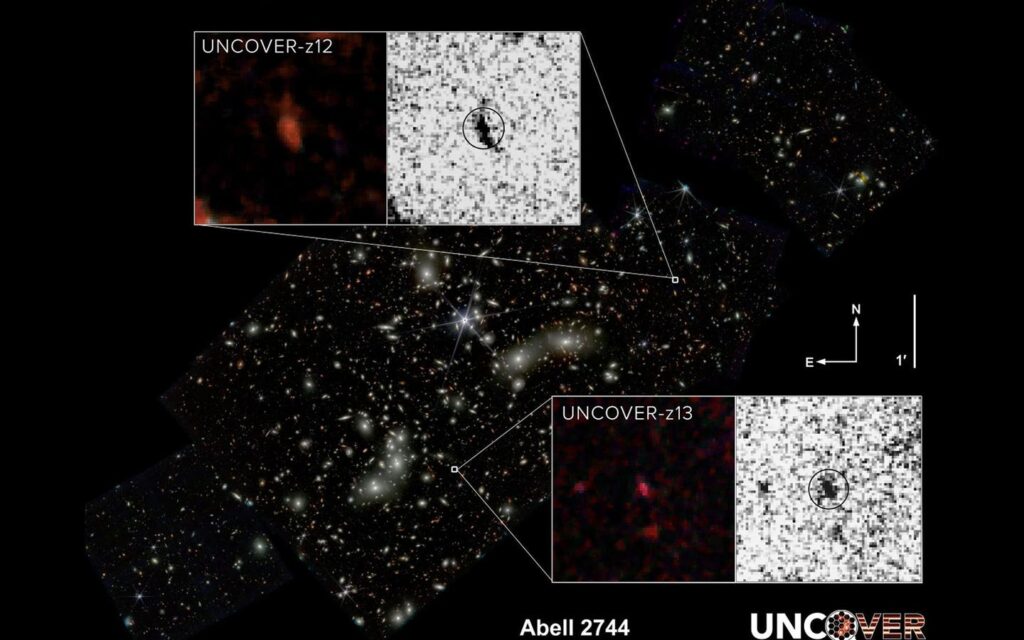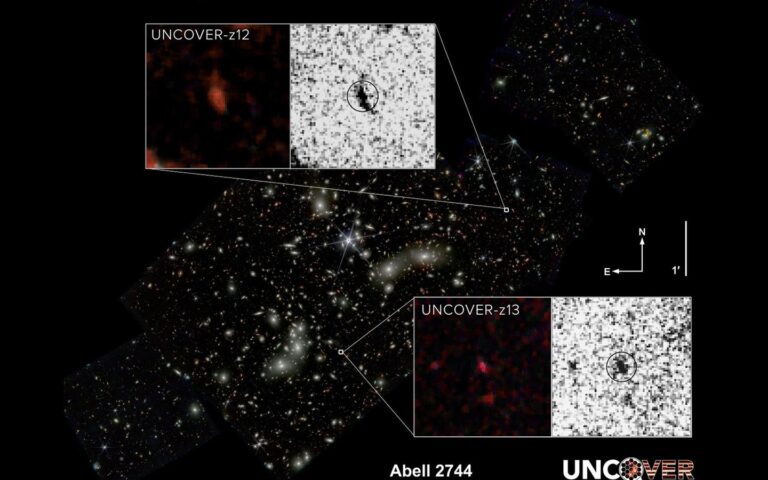The James Webb Space Telescope (JWST) identifies two galaxies at unprecedented distances, marking a significant achievement for astronomers.
The data on UNCOVER z-13 and UNCOVER z-12 helps support the Big Bang theory.
Utilizing NASA’s James Webb Space Telescope, a team has observed two of the most remote galaxies ever recorded, positioned approximately 33 billion light years away from Earth. These distant celestial entities, known as UNCOVER z-13 and UNCOVER z-12, rank as the second and fourth most distant galaxies to date and reside within Pandora’s Cluster (Abell 2744). This groundbreaking discovery, featured in a study published on November 13 in The Astrophysical Journal Letters, sheds light on the potential formation of the universe’s earliest galaxies.

Pandora’s Cluster, selected for deep field imaging due to its location behind several galaxy clusters, creates a natural magnification effect called gravitational lensing. This occurs when the combined mass of the clusters warps space-time, magnifying nearby light and providing an enhanced view behind the clusters. In the images captured by JWST in 2022, the galaxies in Pandora’s Cluster, including UNCOVER z-13 and UNCOVER z-12, appear larger and exhibit shapes reminiscent of a peanut and a fluffy ball, in contrast to the typical red dots associated with galaxies confirmed at such extreme distances.
Astronomer Bingjie Wang, a co-author of the study from Penn State University and a member of the JWST UNCOVER team, highlights the significance of these findings for understanding the early universe. He notes that prior to this analysis, only three galaxies were confirmed at this extreme distance, and studying the newly discovered galaxies reveals the diversity of early galaxies and the valuable insights they offer.
The light emitted by these galaxies, traveling for about 13.4 billion light years to reach JWST, provides a glimpse into the universe’s past, with estimates suggesting the light originated when the universe was approximately 330 million years old. Due to the expansion of the universe, these galaxies are currently situated around 33 billion light years away from Earth. Joel Leja, another co-author and Penn State astronomer, emphasizes that the ancient light from these galaxies serves as a key to understanding the exotic physics governing galaxies near the cosmic dawn.
In terms of size, UNCOVER z-13 and UNCOVER z-12 surpass the previously identified galaxies at similar extreme distances. While our Milky Way galaxy spans about 100,000 light years, these early universe galaxies, measuring 2,000 light years across, challenge expectations of compression in their formation. The team finds the diversity in the properties of these galaxies intriguing and believes their size differences may provide insights into their formation and subsequent evolution.
Detailed models were employed by the team to infer characteristics of these early galaxies, suggesting they were young, had low metal content, and were actively forming stars at a rapid pace. The absence of heavy elements in these early galaxies aligns with theoretical expectations, as these elements would have been produced in the cores of early stars through fusion.
Moving forward, astronomers plan to leverage lensing clusters and JWST instruments to further unravel the timeline and properties of the universe’s earliest galaxies.
Do not forget to share your opinion with us to provide you with the best posts !




0 Comments